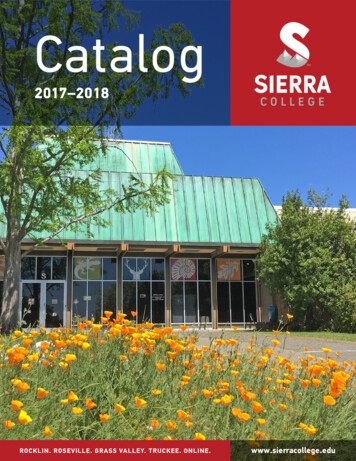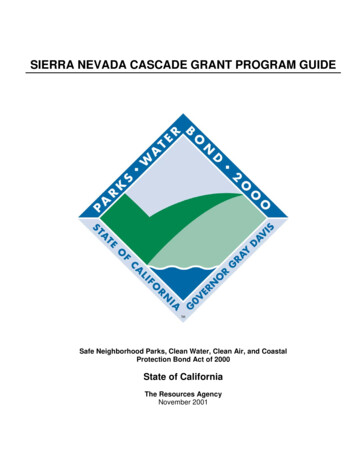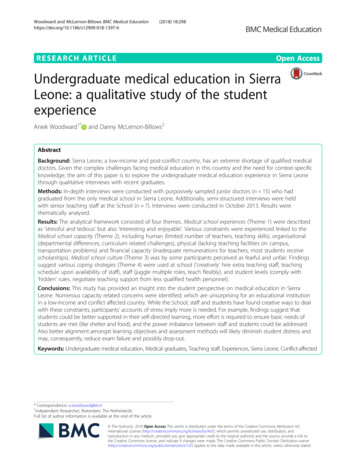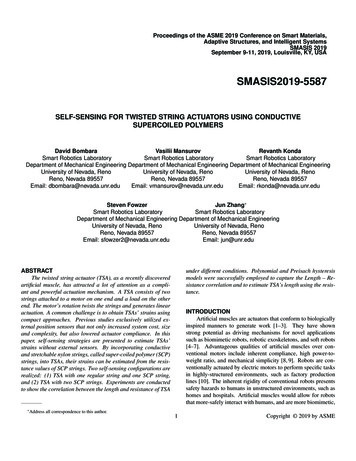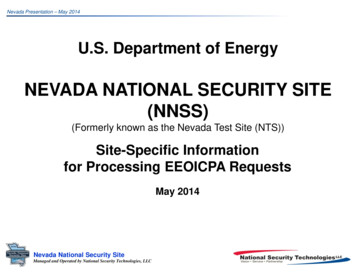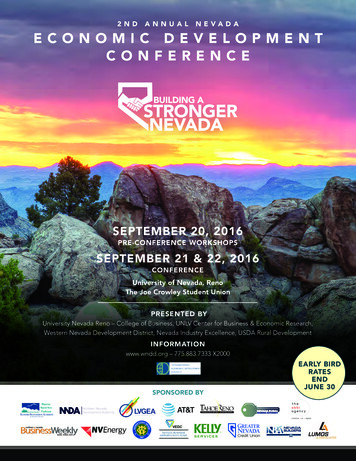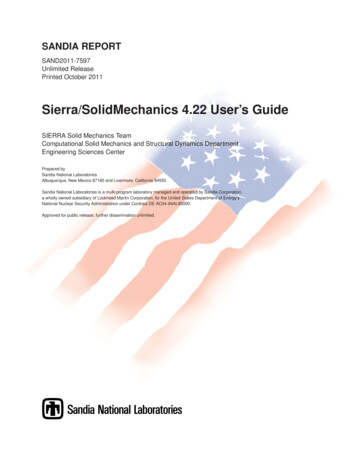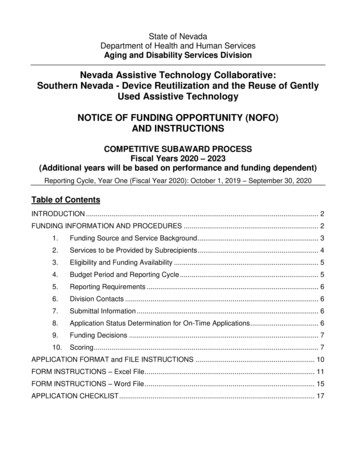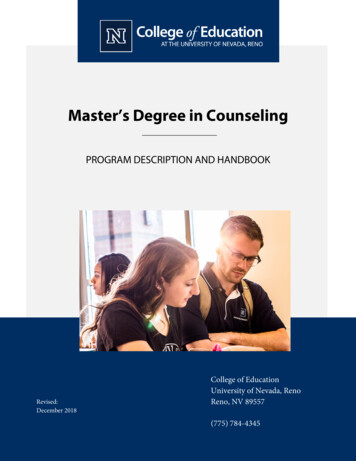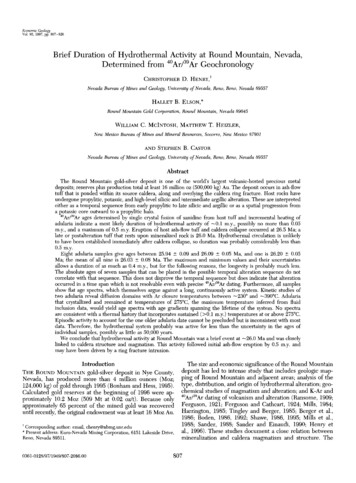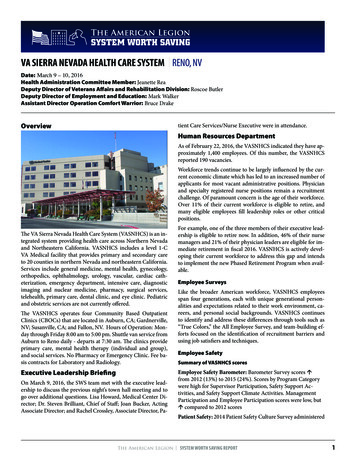
Transcription
The American LegionSYSTEM WORTH SAVINGVA SIERRA NEVADA HEALTH CARE SYSTEM RENO, NVDate: March 9 – 10, 2016Health Administration Committee Member: Jeanette ReaDeputy Director of Veterans Affairs and Rehabilitation Division: Roscoe ButlerDeputy Director of Employment and Education: Mark WalkerAssistant Director Operation Comfort Warrior: Bruce Draketient Care Services/Nurse Executive were in attendance.OverviewHuman Resources DepartmentAs of February 22, 2016, the VASNHCS indicated they have approximately 1,400 employees. Of this number, the VASNHCSreported 190 vacancies.Workforce trends continue to be largely influenced by the current economic climate which has led to an increased number ofapplicants for most vacant administrative positions. Physicianand specialty registered nurse positions remain a recruitmentchallenge. Of paramount concern is the age of their workforce.Over 11% of their current workforce is eligible to retire, andmany eligible employees fill leadership roles or other criticalpositions.The VA Sierra Nevada Health Care System (VASNHCS) is an integrated system providing health care across Northern Nevadaand Northeastern California. VASNHCS includes a level 1-CVA Medical facility that provides primary and secondary careto 20 counties in northern Nevada and northeastern California.Services include general medicine, mental health, gynecology,orthopedics, ophthalmology, urology, vascular, cardiac catheterization, emergency department, intensive care, diagnosticimaging and nuclear medicine, pharmacy, surgical services,telehealth, primary care, dental clinic, and eye clinic. Pediatricand obstetric services are not currently offered.The VASNHCS operates four Community Based OutpatientClinics (CBOCs) that are located in Auburn, CA; Gardnerville,NV; Susanville, CA; and Fallon, NV. Hours of Operation: Monday through Friday 8:00 am to 5:00 pm. Shuttle van service fromAuburn to Reno daily - departs at 7:30 am. The clinics provideprimary care, mental health therapy (individual and group),and social services. No Pharmacy or Emergency Clinic. Fee basis contracts for Laboratory and Radiology.Executive Leadership BriefingOn March 9, 2016, the SWS team met with the executive leadership to discuss the previous night’s town hall meeting and togo over additional questions. Lisa Howard, Medical Center Director; Dr. Steven Brilliant, Chief of Staff; Joan Bucker, ActingAssociate Director; and Rachel Crossley, Associate Director, Pa-For example, one of the three members of their executive leadership is eligible to retire now. In addition, 46% of their nursemanagers and 21% of their physician leaders are eligible for immediate retirement in fiscal 2016. VASNHCS is actively developing their current workforce to address this gap and intendsto implement the new Phased Retirement Program when available.Employee SurveysLike the broader American workforce, VASNHCS employeesspan four generations, each with unique generational personalities and expectations related to their work environment, careers, and personal social backgrounds. VASNHCS continuesto identify and address these differences through tools such as“True Colors,” the All Employee Survey, and team-building efforts focused on the identification of recruitment barriers andusing job satisfiers and techniques.Employee SafetySummary of VASNHCS scoresEmployee Safety Barometer: Barometer Survey scores from 2012 (13%) to 2015 (24%). Scores by Program Categorywere high for Supervisor Participation, Safety Support Activities, and Safety Support Climate Activities. ManagementParticipation and Employee Participation scores were low, but compared to 2012 scoresPatient Safety: 2014 Patient Safety Culture Survey administeredThe American Legion SYSTEM WORTH SAVING REPORT1
The American LegionSYSTEM WORTH SAVINGto staff showed 15 of 15 dimensions below Veterans Health Administration (VHA) averages, with two dimensions scoring twostandard deviations below. This is an improvement howeverfrom 2011 when there were four dimensions that were two standard deviations below national average. Small sample size madegeneralizations difficult. So low scores, but improving.Integrated Ethics: 25% of questions were the lowest of any facility in VA Sierra Pacific Network (VISN 21). 53% were at orbelow the 30th percentile for all National, CO, VO, and VISNquestions. There was a 27.3% response rate as compared to16.2% for 2012RN Satisfaction: Overall nursing satisfaction scores in fiscal2014 are improved relative to fiscal 2012 with better than national gains in Participation, Quality of Care, Registered NurseManager and Staffing categories.Financial ManagementGroup 28,63030,02030,56231,79732,435Highly Female1,9562,2582,2872,4482,341OperationEnduring Freedom (OEF)/OperationIraqi Freedom(OIF)/Operation NewDawn 802HomelessBusiness OfficeThe Business office provided the following statistics on theVASNHCS: Fiscal 2015 Admissions - 3,380 Average Daily Census for each inpatient program – 49 Fiscal 2015 Outpatient visits - 448,715 Fiscal 2016 Projected Outpatient visits - 542,419Historical WorkloadVeteran DemographicsThe VASNHCS catchment area expands to Alpine, El Dorado,Lassen, Modoc, Mono, Nevada, Placer, Plumas and Sierra counties in California. Carson City, Churchill, Douglas, Esmeralda,Eureka, Humbolt, Lander, Lyon, Mineral, Pershing, Storey, andWashoe counties in Nevada are also served by VASNHCS.VASNHCS provides care to a diverse group of veterans. Below isa breakdown of the groups that they 1254,634859,853460,8900CommunityLiving Center (CLC)Discharges295272294377311Bed 8602,84125492,500Bed 682581614Bed 0557Bed geryThe American Legion SYSTEM WORTH SAVING REPORT2
The American LegionSYSTEM WORTH SAVINGNon-Va Coordinated Care Program (NVCC)NVCC budget for the following:Authorized Care Fiscal 2013 - 19,236,000 Fiscal 2014 - 27,446,900 Fiscal 2015 - 25,074,500 (Authorized and Unauthorized, nottracked separately in Fiscal 2015)Unauthorized Care Fiscal 2013 - 1,314,500 Fiscal 2014 - 3,423,000Service-Connected (SC) Emergency Care/Mill Bill Emergency Care1 Fiscal 2013 - 22,760,500 Fiscal 2014 - 31,959,900 Fiscal 2015 - 28,448,4001MONTHLY SUMMARY OF FEE CONSULT REQUESTSFISCAL ryEvaluation595873769475435MammogramFemale Screening634133553468294Radiology / MagneticResonanceImaging (MRI)558360352429286Home BasePrimary CareSkilled Nursing117273882721238Home BasedPrimary CareHome 9150NeurosurgeryProcedure251421172530132Radiology /ComputerizedTomography(CT) Scan13604671126286Dental Specialty Services201421172118111RadiationTherapy Evaluation221624171120110RadiationTherapy Treatment181820161222106Emergency Care is not broken out separately.The American Legion SYSTEM WORTH SAVING REPORT3
The American LegionSYSTEM WORTH SAVINGThere were many more patients sent out last year with the implementation of the Accelerating Care Initiative (ACI). The firstthree months of fiscal 2015 still reflected some of that volume.The Choice program, implemented in November is reducingthe number of NVCC consults.Projected Veteran UtilizationVASNHCS has experienced steady growth in both enrolleesand users over the past several years despite declining veteranpopulation. Looking forward, the Veterans Health Administration (VHA) expects to see increases in outpatient utilization andreductions in inpatient utilization over the next 10-20 years.ServiceFiscal2013Fiscal20185-YearGap %Fiscal202310-YearGap %Fiscal203320-YearGap %Acute Inpatient Medicine13,87711,978-14%10,633-23%8,252-41%Acute Inpatient MentalHealth3,9783,900-2%3,331-16%2,443-39%Acute Inpatient 726%28,56835%28,17033%Ambulatory: Laboratoryand latory: LTSS Homeand Community Based39,41644,37313%48,76824%60,90455%Ambulatory: Medical &Other Non-Surgical atory: MentalHealth y: 57,79914%160,74016%Ambulatory: Radiologyand Nuclear : 9%Blind Rehab42062749%70468%72372%Inpatient ResidentialRehab Mental ,3661,569,6197%1,724,22818%2,004,75737%Ambulatory: Dental ClinicLong-Term Services andSupports InpatientSpinal Cord InjuryPharmacyThe American Legion SYSTEM WORTH SAVING REPORT4
The American LegionSYSTEM WORTH SAVINGQuality ManagementVASNHCS Strategic Priorities: Access: Improvements to increase capacity will better avail patients of quality care within medically appropriate timeframes. Workforce Development: Leadership that is forward-looking,agile, adaptive, high performing, rewarding innovation andsupporting teamwork will proactively recruit, train, develop,reward, motivate, and inspire our workforce. Veteran Engagement: A system that is actively gathering veteran feedback and will appropriately tailor our processes toaddress veteran need will be developed. Community Engagement: Communication with our community stakeholders is essential to enriching our role as a partner and resource in the neighborhoods and districts we serve. Stewardship: As stewards, we must effectively align resourcesto provide quality care and deliver sustained value to veteransand taxpayers alike.Strategic Priorities for Fiscal 2015 and 2016: Inpatient Care: A system-wide approach to improving howpatients move through our inpatient flow, from admission todischarge. Several workgroups will investigate each piece ofthe flow to strategize improvements. Memory Care: Develop a plan to provide an appropriate environment for individuals diagnosed with dementia who areawaiting long-term placement and improve patient care andsafety. Daily Management System: Improve communication relatedto the management of daily operations, ensuring proper elevation of critical information and provide opportunities to remedy challenges at the lowest level.Strategic PlanThe VASNHCS released their fiscal 2015 Strategic Plan on June29, 2015. Their plan, called Strategy for Excellence, begins withthe following VA Strategic Goals: New Employee Onboarding: To address the extended time ittakes to complete employee onboarding, this workgroup willaddress the hiring process phases and establish timeline goalsand create a centralized process to help expedite the onboarding process. Enhance and Develop Trusted Partnerships The VASNHCS achieved Health & Human Service’s Gold Recognition for its participation in the National Hospital OrganDonation Campaign. Manage and Improve VA Operations to Deliver Seamless andIntegrated Support The VASNHCS earned the Gold Standard for its participationin the National Center for Patient Safety Program.VASNHCS Mission: Provide World Class Care and Services toAmerica’s Heroes. The Office of the Inspector General conducted a scheduledaudit in March 2015. Several areas of care were reviewed withrecommendations and follow-up action plans submitted. Action plan implementation and staff education are ongoing. Empower Veterans to Improve Their Well-beingVASNCHS Strategic Goal: Provide veterans personalized proactive, and patient-driven health care. In May 2014, the Joint Commission conducted an unan-The American Legion SYSTEM WORTH SAVING REPORT5
The American LegionSYSTEM WORTH SAVINGnounced two-day survey covering several areas of patient care.Patient access to care was thoroughly reviewed and no recommendations for improvement were identified. The VASNHCS hosted both veteran and community town hallmeetings to facilitate outreach and communication.Women VeteransA total of 1,978 women veterans receive care from the VASNHCS Women’s Clinic. The Women Veterans Program Managerprojects that over the next five years this number will increase to3,773. The Women’s Clinic has on staff one gynecologist and twoprimary care providers at the Reno facility. There is one primarycare provider at the Carson Valley CBOC.The VASNHCS typically hosts 12 events annually to include GoRed for Women Health and Pink Out for Breast Cancer. Themedical center hosted a Women Veterans Town Hall on March18, 2016.VASNHCS Women Veterans Statistics Fiscal 2014 – 41,593 Treated Fiscal 2014 – 31,938 Total Women Veterans in VASNHCS catchment area – 7,619 Total number enrolled – 2,618 Total number receiving care with the HCS – 1,978 Market penetration fiscal 2014 for enrolled women – 0.34 Market penetration fiscal 2014 for women receive care – 0.25 Projected enrollment in five years – 3,773 Projected enrollment in 10 years – 4,241Outreach EventsVASNHCS 2016 OUTREACH CALENDARConfirmedEventDateTimeLocationWomen Veterans Memorial03/18/20161:00 p.m. to3:30 p.m.Main CampusVietnam Veterans Standown03/25/201612:00 p.m. to3:00 p.m.Main CampusSenior Spectrum Baldini’sHealth Fair05/03/201612:00 p.m. to5:00 p.m.Baldini’sKorean WarVeteran’s Association05/05/201610:00 a.m. to12:30 p.m.SparksCrossroads ofthe West GunShow05/21/201605/22/2016To Be DeterminedConventionCenterReno Rodeo05/16/1605/25/201611:00 a.m. to9:00 p.m.LivestockArenaNative American VeteransTown Hall06/23/20163:00 p.m. to4:30 p.m.Main CampusHot AugustNight08/02/201608/07/201610:00 a.m. to9:00 p.m.Grand SierraResortSenior Spectrum SeniorFest09/06/2016To Be DeterminedOld Town HallReno BighornsLegal ClinicMultiple Dates12:00 p.m. to3:30 p.m.Reno EventCenterVASNHCS 2016 OUTREACH CALENDARUnconfirmedEventDateTimeLocationGrass ValleyOutreach FairSummer 2016TBDGrass Valley,CAReno SparksIndian ColonyOutreachLate Spring2016TBDTBDStreet Vibrations06/21/2016TBDReno/SparksHerlong ArmyDepotTBDTBDHerlong, CAReno Aces Military & Vet GamesTBDTBDAces BallparkLovelock FWelcome HomeEventAugust /SeptemberTBDRenoThe American Legion SYSTEM WORTH SAVING REPORT6
The American LegionSYSTEM WORTH SAVINGData BreachesConstruction Project:Over the last three fiscal years, the VASNHCS reported 219 databreaches. Veterans Health Administration (VHA) defines a databreach violation as “the loss, theft, or other unauthorized access,other than those incidentals to the scope of employment, to datacontaining sensitive personal information (SPI), in electronicor printed form, that results in the potential compromise of theconfidentiality or integrity of the data.” To reduce the number ofdata breaches, employees are required to undergo Privacy andHIPAA training in person or through VA’s Talent ManagementSystem (TMS).Project Name1st FundRenovate and Rightsized Operating Rooms2017Execute New North Campus lease to provide Patient Aligned CareTeam Clinic2017Renovate and Expand Operating Room Support Areas2018Expand/Renovate Magnetic Resonance Imaging Space2018Renovate Space Adjacent to the Intensive Care Unit Wing B3 ofBuilding 122018Convert Facility to Electronic Proximity Care Locking System2018Procure Land for Campus and Parking Expansion to increaseSecurity Setbacks2018Expand Emergency Power Capacity at the Boiler Plant2018Replace damaged piping in clinical Building 1D2018Repair critical electrical deficiencies in Clinical Building 1D2018Execute New South Campus lease to Provide Patient Aligned CareTeam Clinic2018Provide emergency Water Tank Supply2019Provide Bird Protection for Patient Safety and Infection Control2019Replace Air Handling Units Serving Building 122019Provide Sewer Storage Tanks for Emergency Management2019Construct Solar Plane Array on New Parking Garage2019Install New Energy Efficient Chiller and Cooling Tower2019Construct Parking Garage2019Correct Seismic Bracing for Non Structural Components & Equipment in Critical Patient Care Areas2019Renovate Wing B4 of Building 12 for Single Patient Rooms2019Renovate Sterile Processing Service2020Construct New Community Living Center Building (Pod 3)2020Repair Exterior Walls for building throughout campus2020Renovate Vacant Primary Care for Pharmacy2020Realign Center Cores of Wings B4 and B5 in Building 122021Construct New Wellness Center2021Construct Solar Panel Array on Second New Facility Parking Garage2021Extend Elevators to Roof for Improved Maintenance Access2022Construct New Community Living Center Building (Pod 1)2022Construct Third Parking Garage2023Construct New Inpatient Mental Health Ward2023The American Legion SYSTEM WORTH SAVING REPORT7
The American LegionSYSTEM WORTH SAVINGTown HallOn March 8, 2016, a town hall meeting was held at 7:00 pm atthe American Legion Post One at 877 Ralston Street, Reno, Nevada, to hear firsthand from veterans and family members abouttheir VA health care experience. In addition to veterans and theirfamily members, the following American Legion Department ofNevada officials were in attendance: Lionel Motta, DepartmentAdjutant; David S. Evans, Department Commander; John Warden, Alternate National Executive Committeeman (NEC); andJack Edstrom, Post One Commander. Glenna Smith, RegionalRepresentative, Senator Dean Heller’s Office; and Tracy Soliday,Constituent Service Representative, Congressman Mark Amodei represented the local Congressional field offices. Lisa Howard, Medical Center Director, represented VASNHCS.Following are the concerns that were raised during the town hallmeeting. Barbara from Las Vegas VAMC reported that she was referredto California for dental care. Veterans are upset that they arenot being seen at VA and want an explanation. Danny commented that he is proud to have been a VA patientfor 28 years and has had only had one problem with specialtycare. Ben said he used My HealtheVet and got immediate appointments for audiology & eye care. Clinics are open weekends toaccommodate the needs of veterans. A male veteran who needs cataract surgery says he does notqualify for Choice since the CBOC is within a few miles of hishome. The shuttle from Minden to Reno only has three seatsand fill quickly. He sought help from the Patient Advocate andwas dissatisfied with the resolution provided. He cannot drivehome from the procedure and has no other transportation.The veteran is in need of hearing aids but has surpassed themeans test threshold. A female veteran disclosed that when she needed pacemakerand cataract surgery she was referred to a California VA instead of a local community provider. David said he has received care at Washington, D.C. VAMCand that Reno VAMC is the better of the two. The director would like to discontinue appointment cards asthey frequently provide incorrect information.On March 18, 2016, the VASNHCS conducted a separate Women Veterans Town Hall. Ms. Lisa Howard, VASNHCS Director, opened the town hall and introduced a panel comprised ofDr. Elizabeth Hill, Associate Chief of Staff, Research; Dr. AmySanguinetti, Associate Chief of Staff, Ambulatory Care; and Dr.Steven Brilliant, Chief of Staff. Each panel member presentedon various VASNHCS services offered to women veterans. Ms.Howard spoke of VASNHCS’ commitment to outreach and service to women veterans and offered that in an area adjacent tothe town hall, the Veterans Benefits Administration (VBA) wasavailable to work with veterans with specific claims issues. Shealso announced that the Joint Commission had conducted a triannual survey that week, and that surveyors were complimentary of the services that VASNHCS provides.There were approximately 20-30 people in attendance and thecomments were mostly positive. Acting Women Veterans Program Manager Christie Lambert discussed community outreachand the facility’s efforts to revive the Women Veterans Committee. Ms. Howard asked the room for assistance in spreading theword about the services VASNHCS offers women veterans.Afterwards, participants strolled outside to attend a Women Veterans Memorial Garden with formal ceremony including Congressional, State Government, and Governor Representatives,VSO’s, veterans and community members. The keynote addresswas Kat Miller, Director of the Nevada Department of VeteransServices. The ceremony included the University of Nevada, RenoArmy ROTC (UNR ROTC) Women Cadet Color Guard, a traditional Native blessing, and a Military Enlistment Ceremony.Operation Comfort Warrior (OCW)The American Legion Operation Comfort Warrior (OCW) inconjunction with the Department of Nevada American LegionReno Post #1, presented the VASNHCS an OWC grant of 5,700which was used to purchase comfort and recreation items forhospitalized patients. These items were delivered to the medicalcenter on March 10, 2016, and presented to Stephanie Torian,Chief of Voluntary Service.Homeless ShelterOn Thursday, March 10; Mark Walker, Deputy Director VE&EDivision; Roscoe Butler, Deputy Director VA&R Division; alongwith the System Worth Saving Team (Department of Nevada);met with Elizabeth Pope, Coordinator/Supervisor Health Carefor Homeless Veteran (HCHV) Program, to discuss their programs and services as well as their plan to eliminate veteranhomelessness in the Reno area. The HCHV Program assistsveterans with connecting them to VA and community services.Services include: Transitional and permanent housing; Medicalcare; Mental health referrals; Drop-in services for laundry andshowers; and other resources to improve the quality of life forveterans.Currently, there are 187 homeless veterans (11 in the rural area)in Reno. Please note – this number comes from the most recentPoint-in-Time Count, which means that it is an estimate of theThe American Legion SYSTEM WORTH SAVING REPORT8
The American LegionSYSTEM WORTH SAVINGarea’s homeless veteran population. Reno has been awarded 450(Housing and Urban Development) HUD-Veterans Affairs Supportive Housing (HUD-VASH) vouchers. HUD-VASH vouchersprovide permanent housing for chronically homeless veteranswho may have mental illness and substance abuse disorders. Theprogram is supported by the VA and HUD. VA staff provide outreach, clinical care and intensive ongoing case management services. At this moment the Mayor of Reno, Hillary Schieve, hasnot signed onto the Mayors Challenge to End Veteran Homelessness. Through the Mayors Challenge mayors and other stateand local leaders across the country have marshaled federal, local, and nonprofit efforts to end veteran homelessness in theircommunities. Ending veteran homelessness means reaching thepoint where there are no veterans sleeping on America’s streetsand every veteran has access to permanent housing. Shouldveterans become homeless or be at-risk of becoming homeless,communities will have the capacity to quickly connect them tothe help they need to achieve housing stability. The Departmentof Nevada will be contacting Mayor Schieve’s office to discuss thepotential of her signing onto the Mayor’s Challenge.Additionally, the team visited a shelter in downtown Reno. Volunteers of America has contracted beds within the shelter forhomeless veterans. The shelter provides housing as well as support services and referrals for permanent housing, health care,education and career opportunities. Lastly, the VA, service providers, and other stakeholders are moving in the direction ofbetter coordination in order to properly help homeless veteransand their families. To end veteran homeless within a community,there needs to be consistent communication, accountability andleadership with all involved.Vet CenterOn Thursday, March 10, Deputy Director Roscoe Butler, VA&RDivision Deputy Director Mark Walker, Vocational Rehabilitation and Employment (VR&E), and the Department of NevadaSystem Worth Saving Team met with Scott Drew who TeamLead at the Reno Vet Center. Mr. Drew apprised the group onthe role of the Reno Vet Center and gave a tour of the facility aswell as the Vet Center Mobile Van.Best PracticesThe VASNHCS identified the following best practices: Access Best Practice – In early 2014, the average wait time fora first primary care appointment was 42 days. A Rapid ProcessImprovement Workshop was held, and a robust new enrolleepatient process was developed. As a direct result of this effort,96% of new veteran enrollees are seen on the same day. Theremaining four percent had average wait time was down to 3days within just two months of implementation. The currentwait time is 1.24 days. Clinic Practice Management (CPM) - The establishment of aclinic practice management team with reporting structure hasbeen critical to VASNHCS’ success in improving access, quality of care, and communication. The basic structure includesa group practice manager (GPM) who reports to the chief ofstaff (COS), and a weekly CPM model meeting. The GPM,COS, CPM team, and an ad hoc guest all attend.Average Wait Time in DaysCompleted Appointments as of 12/30/ 2015:»» Primary Care: 3.81»» Specialty Care: 7.26»» Mental Health: .40 My Life, My Story captures veterans’ stories of their life andexperiences for the inclusion of a 2-page summary in VA’selectronic medical record. The VA Sierra Nevada Health CareSystem was selected as a pilot location for an excellent project to enhance the experience of our veterans and Honor theirService. This program allows the clinical team an opportunityto know more about the whole veteran, not just their medicalhistory. The facility’s Honors Escort Program provides a formal transfer of a recently deceased veteran from their hospital room tothe facility morgue. A special gurney with a frame is used andan American flag is draped over the gurney. Specially trainedstaff and volunteers serve as escorts. Employees and visitorswho are in hallways when the procession passes stand to theside and salute or place a hand over the heart. After the procession, family members are provided the opportunity to assistwith folding the flag. An article describing this unique way ofpaying tribute to veterans was featured in the October–November 2014 issue of VAnguard, a VA employee magazine. VA Voices uses the power of storytelling to build connectionsbetween employees, veterans, and the community. These relationships foster empathy, build trust, and create effective partnerships in healthcare. During the VA Voices experience, employees hear personal stories from the local leadership team,participate in team building activities, and learn strategies toshare their story to build stronger connections in support ofthe mission of serving veterans.Conclusion1.Staffing: Staffing at VASNHCS remains a challenge as theycompete for scarce healthcare resources. Nevada is in theprocess of opening a medical school in Las Vegas that mayserve as a source of future applicants. However, the VA as aThe American Legion SYSTEM WORTH SAVING REPORT9
The American LegionSYSTEM WORTH SAVINGwhole continues to struggle to fill vacant positions with experienced staff. Over 11% of VASNHCS current workforceis eligible to retire; many eligible employees fill leadershiproles or other critical positions. For example, one of thethree members of VASNHCS executive leadership is eligibleto retire now. Also, 46% of their Nurse Managers and 21%of their physician leaders were eligible for immediate retirement in fiscal 2015.2.Centralization of HR: When asked if consolidation of HRwould have a positive or adverse effect on the hiring and recruitment process, the SWS team was advised that it wouldbe a disaster and would take away any local control andoversight from medical center Directors. The centralizationof Prosthetics and Procurement Services nationwide wascited as an example of unsuccessful implementation.3.The catchment area is large and very rural: The catchmentarea for the VASNHCS is the 2nd largest rural district in thecountry. It is comprised of 110,000 square miles of territoryin northern Nevada and California. Veteran populations arescattered across a multitude of small rural towns in 20 counties.4.Considerable driving distance for veteran: Many veteranstravel upwards of 3.5 hours one-way to access care at theVASNCHS. The furthest eastern edge of their catchmentarea, for example, is 253 miles away on I-80. They haveplaced CBOCs in many sectors, including a part-time outreach clinic. VASNHCS opened another primary care site inReno and will open an additional PC site in North ValleysReno in fiscal 2016.5.Communication: The rural nature of the catchment areain Nevada makes for limited communication options withregards to notifying veterans. Reno itself has a tiny mediamarket. There are only three Network Television stationsand one regional newspaper. The proliferation of web-basedplatforms such as social networking have expanded optionssomewhat, but many older veterans do not utilize these resources.6.Lack of in-house resources: During the Clinical ServiceChiefs meeting with The American Legion, the topic ofinpatient beds was discussed. VASNHCS has a multi-yearValue Stream addressing inpatient bed flow and monitorsthe cumulative census to identify opportunities to increasethe bed count. VASNHCS has six beds that could be activated that are also being considered for memory care needs.7.Space: Space is a challenge as the VASNHCS is landlockedin a residential neighborhood with insufficient parking.VASNHCS is in design for a Major Project, which will provide for modern outpatient delivery. There are also manyminor projects underway f
Health Administration Committee Member: Jeanette Rea . The Business office provided the following statistics on the VASNHCS: Fiscal 2015 Admissions - 3,380 . (NVCC) NVCC budget for the following: Authorized Care 221Fiscal 2013 - 19,236,000 Fiscal 2014 - 27,446,900
